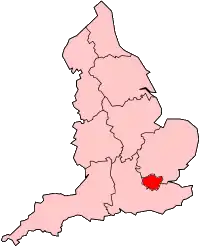Greenwich Power Station
Greenwich Power Station is a standby gas and formerly oil and coal-fired power station on the River Thames at Greenwich in south-east London.
| Greenwich Power Station | |
|---|---|
 Greenwich Power Station with The O2 visible in the background. | |

| |
| Country | United Kingdom |
| Location | Greater London |
| Coordinates | 51.485°N 0.001°W |
| Status | Operational |
| Construction began | 1902 |
| Commission date | 1906 |
| Thermal power station | |
| Primary fuel | Gas |
| Cogeneration? | Yes |
| Power generation | |
| Units operational | 6 |
| Nameplate capacity | 155 MW |
| External links | |
| Commons | Related media on Commons |
grid reference TQ389781 | |
The station was designed by the London County Council architects department, and built in two sections between 1902 and 1910, to provide power for the London County Council Tramways. The first section was formally opened on 26 May 1906 by Sir Evan Spicer, chairman of the County Council.[1] Surplus power was used by other electric tramways and the Underground Electric Railways Company of London. The station originally had a coal-fired boiler house and an engine room. This housed four compound reciprocating steam engines driving flywheel-type alternators with an output of 6,600 volts at 25 Hz.
By 1910 the advantages of steam turbines were well known and four steam turbine alternators were installed in the second stage of the station's building programme. The reciprocating engines installed during the first stage were replaced by steam turbines in 1922.
The two chimneys of stage one were 249 ft (76 m) high but, following objections from the nearby Royal Observatory, the chimneys of stage two were reduced to only 180 ft (55 m) height.
The steam turbines were replaced by Rolls-Royce gas turbine generators, used engines similar to those used in jet aircraft. These originally burned oil, but were later converted to burn oil and gas. The generators are still housed in what was formerly the boiler house. They have a total capacity of 117.6 megawatts (MW), generated at 11,000 volts. This voltage can be increased to 22,000 volts for connection to the London Underground electricity system.[2] TfL is working on a plan to install up to six new gas engines in Greenwich Power Station's Old Turbine Hall. They would provide a steady source of reliable, low carbon power for the Tube as well as hot water and heating for nearby schools and homes.[3]
The station is an early example of a steel-framed building with a stone-clad brick cover.[4]
Operations
Coal was delivered to the large coal jetty in the river, which stands on 16 Doric-styled, cast iron columns. Coal was then sent to the white-painted storage bunkers on the west side of the station.
The pier is now no longer used because the relatively small amount of oil used at the station now comes by road tanker. Burning gas and oil does not produce the amount of ash that burning coal does, so it is not removed via the jetty as the coal ash used to be.
In popular culture
The power station with its four distinctive chimneys can be seen in the music video for "The Importance of Being Idle", a song by the English rock band Oasis which reached number one in the UK charts in 2005.
References
- "Vauxhall-Bridge And Greenwich Electricity Station". The Times (38031). 28 May 1906. p. 11. Retrieved 7 October 2017.
- "Greenwich Power Station - Graces Guide". www.gracesguide.co.uk.
- https://tfl.gov.uk/travel-information/improvements-and-projects/greenwich-power-station
- "Greenwich Power Station". Port Cities. Retrieved 5 August 2008.
| Wikimedia Commons has media related to Greenwich Power Station. |
